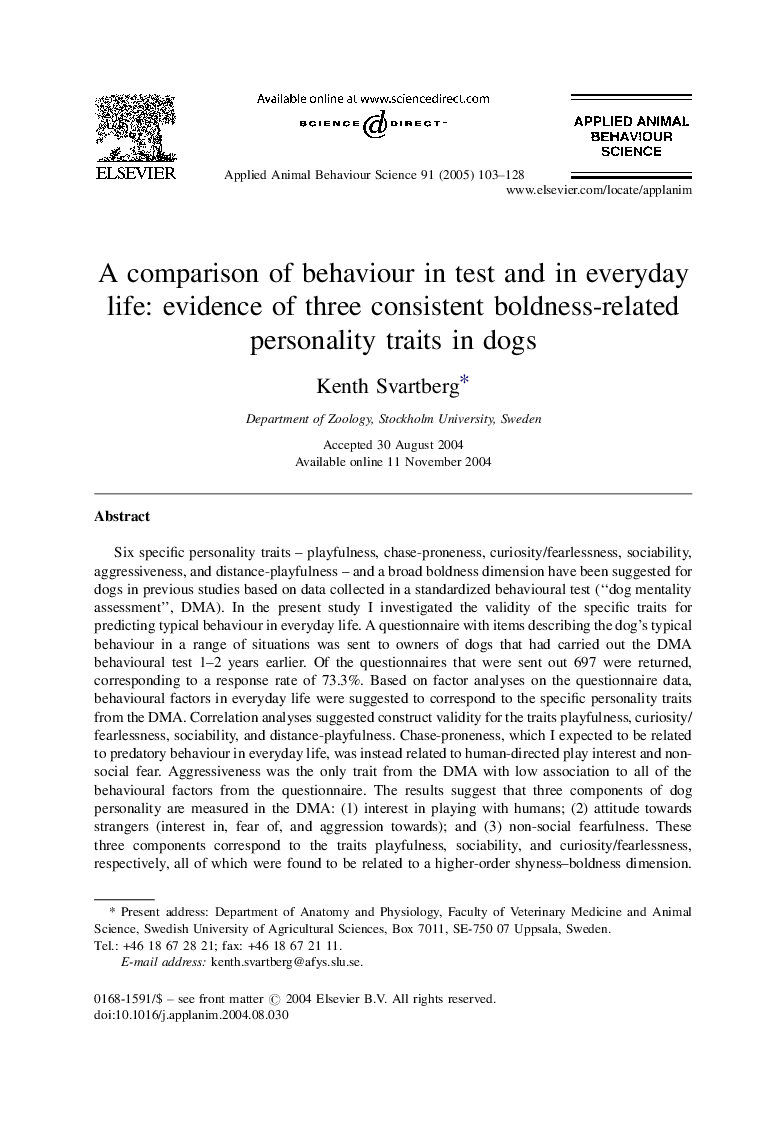| کد مقاله | کد نشریه | سال انتشار | مقاله انگلیسی | نسخه تمام متن |
|---|---|---|---|---|
| 9475846 | 1625458 | 2005 | 26 صفحه PDF | دانلود رایگان |
عنوان انگلیسی مقاله ISI
A comparison of behaviour in test and in everyday life: evidence of three consistent boldness-related personality traits in dogs
دانلود مقاله + سفارش ترجمه
دانلود مقاله ISI انگلیسی
رایگان برای ایرانیان
کلمات کلیدی
موضوعات مرتبط
علوم زیستی و بیوفناوری
علوم کشاورزی و بیولوژیک
علوم دامی و جانورشناسی
پیش نمایش صفحه اول مقاله

چکیده انگلیسی
Six specific personality traits - playfulness, chase-proneness, curiosity/fearlessness, sociability, aggressiveness, and distance-playfulness - and a broad boldness dimension have been suggested for dogs in previous studies based on data collected in a standardized behavioural test (“dog mentality assessment”, DMA). In the present study I investigated the validity of the specific traits for predicting typical behaviour in everyday life. A questionnaire with items describing the dog's typical behaviour in a range of situations was sent to owners of dogs that had carried out the DMA behavioural test 1-2 years earlier. Of the questionnaires that were sent out 697 were returned, corresponding to a response rate of 73.3%. Based on factor analyses on the questionnaire data, behavioural factors in everyday life were suggested to correspond to the specific personality traits from the DMA. Correlation analyses suggested construct validity for the traits playfulness, curiosity/fearlessness, sociability, and distance-playfulness. Chase-proneness, which I expected to be related to predatory behaviour in everyday life, was instead related to human-directed play interest and non-social fear. Aggressiveness was the only trait from the DMA with low association to all of the behavioural factors from the questionnaire. The results suggest that three components of dog personality are measured in the DMA: (1) interest in playing with humans; (2) attitude towards strangers (interest in, fear of, and aggression towards); and (3) non-social fearfulness. These three components correspond to the traits playfulness, sociability, and curiosity/fearlessness, respectively, all of which were found to be related to a higher-order shyness-boldness dimension. Chase-proneness and distance-playfulness seem to be mixed measures of these personality components, and are not related to any additional components. Since the time between the behavioural test and the questionnaire was 1-2 years, the results indicate long-term consistency of the personality components. Based on these results, the DMA seems to be useful in predicting behavioural problems that are related to social and non-social fear, but not in predicting other potential behavioural problems. However, considering this limitation, the test seems to validly assess important aspects of dog personality, which supports the use of the test as an instrument in dog breeding and in selection of individual dogs for different purposes.
ناشر
Database: Elsevier - ScienceDirect (ساینس دایرکت)
Journal: Applied Animal Behaviour Science - Volume 91, Issues 1â2, May 2005, Pages 103-128
Journal: Applied Animal Behaviour Science - Volume 91, Issues 1â2, May 2005, Pages 103-128
نویسندگان
Kenth Svartberg,